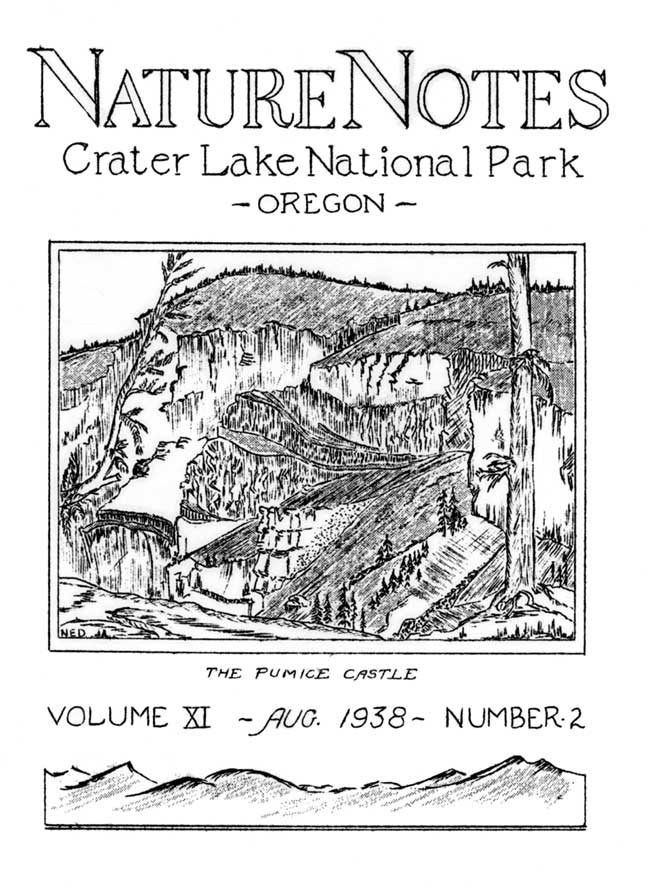
Volume 11 No. 2 – August 1, 1938All material courtesy of the National Park Service.These publications can also be found at http://npshistory.com/Nature Notes is produced by the National Park Service. © 1938. |
Crater Lake National Park
The park includes an area of 250 square miles on the crest of the Cascade Range in southern Oregon. The area was established as a national park in 1902, preserving the unsurpassed scenic beauty of Crater Lake, a deep lake, the clear fresh water of which reflects and refracts unusual hues of blue. Color is only one of the elements of the inspiring beauty of Crater Lake. Its setting is unique. The lake, having an area of 20 square miles, is cupped within the crater of an extinct volcano. Cliffs 500 to 2000 feet high completely surround the lake. The crater walls are partially mantled with hemlock, fir, and pine trees. On the gentle outer slopes of the mountain which one ascends in approaching Crater Lake there are deep canyons, magnificent forests and open meadows supporting a colorful display of mountain wild flowers. Hiking and fishing are popular outdoor sports during the summer months. Skiing is popular in the winter, and the park being accessible throughout the winter months by the west entrance road from Medford and the south entrance road from Klamath Falls.
Oregon Caves National Monument
This national monument, an area of 480 acres, is located in the Siskiyou Mountains in southwestern Oregon. The caves, named “The Marble Halls of Oregon” by Joaquin Miller, are truly marble halls. Underground water penetrating to great depth along fractures in the marble formation has dissolved out an extensive system of chambers. Water dripping from the ceiling and walls has decorated the halls and passageways with fantastic stalactites and stalagmites which stimulate one’s imagination as well as one’s appreciation of the beauties of nature in caverns never touched by sunlight. In the magnificent forest around the cave entrance there are trails along which one gets inspiring views of forest-covered mountains and valleys. Along the trails one can observe many species of trees, mammals, and birds.
Lava Beds National Monument
Located in northeastern California, the monument includes an area of 45,000 acres. As the name suggests, volcanic formations, some of quite recent origin, are of greatest importance. There are hundreds of lava tubes which were once the passageways for streams of molten lava. Volcanic cones rise above the general level of the adjacent country. There are excellent examples of “aa” and “pahoehoe” lava flows. Within the monument there are interesting historical features including battlefields of the Modoc War of 1872-73. There are important ethnological and archaeological features. Petroglyphs on cliffs and pictographs in caves are evidence that the region was inhabited by primitive people long before the coming of the white man.
Check lists of bird species in specific areas are indispensable to the scientific investigator but not much use to the average tourist who is interested in birds.
The tourist may be impressed with the richness of the display on paper, which many years of investigation on the part of a number of observers has accumulated, but what he would like to know is, “What birds am I likely to see in a given locality if I go there during a certain season of the year”.
To fill this need a few bird census reports have been made of some of the areas in Crater Lake National Park which are readily accessible to tourists who may wish to study birds. Vernacular names for the observed species are used and they are written in the order in which the birds were encountered.
Head of Lake Trail, Rim Village
8:30 to 10:00 A.M., June 24, 1937
Elevation – 7100 feet
Clark’s Nutcracker
Northern Pine Siskin
Ruby-crowned Kinglet
Sierra Hermit Thrush
Thurber’s Junco
Townsend’s Solitaire
Cassin’s Purple Finch
Audubon’s Warbler
Information Building, Rim Village
1 P.M., June 26, 1937
Elevation – 7100 feet
Bailey’s Mountain Chickadee
Black-headed Jay
Townsend’s Solitaire
Hawk (Sharp-shinned)
Cassin’s Purple Finch
Thurber’s Junco
Clark’s Nutcracker
Western Chipping Sparrow
Audubon’s Warbler
Crater Lake Rim Village Area
8:30 to 11:30 A.M., June 27, 1937
Elevation – 7100 feet
Clark’s Nutcracker
Cassin’s Purple Finch
Mountain Bluebird
Western Robin
Northern Pine Siskin
Thurber’s Junco
Western Chipping Sparrow
Audubon’s Warbler
Sun Notch, East Rim of Crater Lake
9:00 to 11:30 A.M., July 2, 1937
Elevation – 7115 feet
Bailey’s Mountain Chickadee
Northern Pine Siskin
Thurber’s Junco
Western Chipping Sparrow
Cassin’s Purple Finch
Ruby-crowned Kinglet
Golden-crowned Kinglet
Red-breasted Nuthatch
Audubon’s Warbler
Launch Trip on Crater Lake
9:00 to 11:45 A.M., July 7, 1937
Note: This report includes observations made
from the launch circling the lake as well as along
the trail going to and from the lake.
Trail Down to the Lake
Ruby-crowned Kinglet
Red-tailed Hawk
Near Wizard Island
Olive-sided Flycatcher
Thurber’s Junco
Townsend’s Solitaire
Spotted Sandpiper
Steel Bay
Red-tailed Hawk
Grotto Cove
Bald Eagle
Danger Bay
Violet-green Swallow
Trail up from Lake
Audubon’s Warbler
Cassin’s Purple Finch
Western Tanager
Forest Road West of Pinnacles and Sand Creek Valley
9:00 to 11:00 A.M., July 11, 1937
Elevation – 5,500 to 6,000 feet
Western Robin
Mountain Bluebird
Green-tailed Towhee
Black-headed Jay
Western Chipping Sparrow
Western Tanager
Sierra Hermit Thrush
Bailey’s Mountain Chickadee
Red-breasted Nuthatch
Calaveras Warbler
Red-breasted Sapsucker
Thurber’s Junco
Olive-side Flycatcher
Western Flycatcher
Rough-winged Swallow
Northern Pine Siskin
Swainson’s Hawk
Golden Pileolated Warbler
Sand Creek Valley
9:00 to 11:00 A.M., July 13, 1937
Elevation – 5,500 to 6,250 feet
Mountain Bluebird
Olive-sided Flycatcher
Black-headed Jay
Western Chipping Sparrow
Sierra Hermit Thrush
Western Tanager
Bailey’s Mountain Chickadee
Red-breasted Nuthatch
Calaveras Warbler
Red-breasted Sapsucker
Green-tailed Towhee
Thurber’s Junco
Western Pileated Woodpecker
Audubon’s Warbler
Golden Pileolated Warbler
Cassin’s Purple Finch
Western Flycatcher
Northern Pine Siskin
Swainson’s Hawk
Rough-winged Swallow



